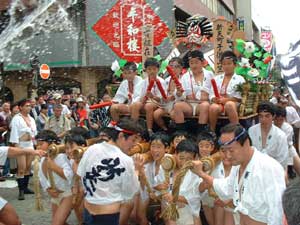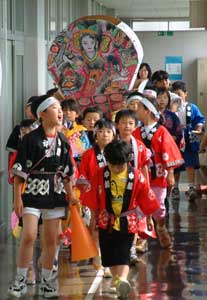MONTHLY NEWS Kids Take Part In Summer Festivals |
Japan's traditional summer festivals are celebrations held by people for the purpose of praying for good fortune, for example that they do not suffer flood damage or disaster and that they do not fall ill during the hot season. Summer festivals are held all across Japan. They feature such events as dancing and parades of portable shrines. The atmosphere at a summer festival is usually quite exciting, as many shops open up stalls outside selling food and drinks and offering games in which children can try to win prizes. For kids, seeing the sights at a summer festival is a highlight of the summer, and some even get to participate in the festivals. Many people want kids to be able to experience the traditional activities of their local area, so there are sometimes special children's versions of the festivals separate from the main event. Well known in western Japan is the Hakata Gion Yamakasa Festival held in Fukuoka Prefecture. During the festival, there is a special event called Children's Yamakasa, in which 400 kids take part. First, the children learn about the history and customs involved in the festival. For example, at the beginning and end of the festival, participants clap together in response to a call: "Yo!" (clap twice) "One more time!" (clap twice) "Yo!" (clap three times). Doing this together builds a feeling of togetherness among the participants. After this, the participants change into their festival costumes and then carry the yamakasa (large floats) around the city. The yamakasa are very big, and even the one specially made for children weighs 500 kilograms (1,100 pounds)! Calling out together, the kids carry the heavy yamakasa 400 meters down the road, impressing adults with their strength of spirit.
In Aomori Prefecture's Hirosaki City, located in the Tohoku region, the Neputa Festival (a version of the Nebuta Festival held elsewhere in Aomori) has been incorporated into the curriculum at Chien Elementary School. The students copy the real version of a float called neputa and create their own smaller versions over a period of one month. The kids draw colorful pictures of warriors on one-square-meter sheets of paper, attach the drawings to fan-shaped plates, and put the plates on the neputa. During their own festival, the kids carry the neputa in time with music played on the fue (a type of flute) and the taiko (Japanese drum) as they parade around the school grounds. Kids get to learn about history, traditional culture, and working together as they experience local summer festivals. Even after they grow up and become adults, they will still cherish memories of these fun times. Photos: The Hakata Gion Yamakasa Festival (Yoshikazu Shibata); (bottom) The Neputa Festival at Chien Elementary School (Chien Elementary School). |

|

